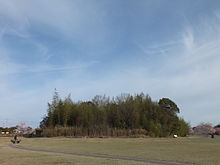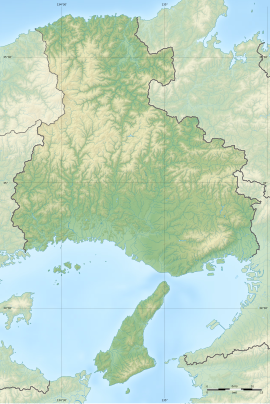279:
34:
79:
51:
86:
58:
315:, which is shaped like a keyhole, having one square end and one circular end, when viewed from above. It dates from the middle of the Kofun period, and has a total length of about 109 meters, with an anterior width of about 54 meters, and a posterior circular diameter of about 64 meters, making it the fifth largest in Hyogo Prefecture. The tumulus was consisted in three tiers and was encircled by a moat with a width of about 20 meters.
656:
427:
tumulus with diameter of 17 meters, surrounded by a three-meter wide moat. It is located 110 meters to the southeast of the
Tamaoka Kofun. Fragments of cylindrical haniwa have been recovered from the moat. The horizontal hole type stone burial chamber opens toward the south. However, most of the
501:
dang from the late Kofun period. It has a total length of 51 meters, with an anterior width of 16 meters, posterior diameter of 43 meters and is orientated to the east. At the top of the posterior circular portion, the pit-type stone burial chamber is exposed. Traces of a moat with a width of 10
365:
tumulus with diameter of 25 meters, but has been severely modified and may have originally been a keyhole-shaped tumulus. Haniwa and
Fukiishi fragments have been found in its surrounding moat. Baizuka No.2 is a square
479:
were robbed in antiquity. Surviving grave goods included fragments of iron swords, armor and agricultural tools, as well as earthenware shards. The tumulus's located 170 meters west of the
Tamaoka Kofun.
275:. The cluster shows a wide variety of styles, and once consisted of over 30 tumuli in the surrounding area, most of which were destroyed due to the development of residential land.
135:
263:. The Tamaoka Kofun was individually designated a National Historic Site in 1943, with the others added in 1978 and the area under protection expanded in 1997.
428:
stone materials used, including the ceiling of the stone chamber, have been removed. The tumulus dates from the middle of the Kofun period (early 5th century).
335:
sarcophagus can be seen. The tumulus os the stage for a tragic love story involving Nichijō-hime, as recounted in the local history "Harima
Kokudoki".
278:
33:
78:
475:. It thought to have housed a split bamboo-shaped wooden coffin, but it is probable that many of the stones were removed and most of the
564:
352:
The
Baizuka No.1 and No.2 Kofun are secondary tumuli flanking the Tamaoka Kofun to the east and west. Baizuka No.1 is a circular
693:
660:
540:
pottery. It was located at the
Azajoten-ji temple in the Satani neighborhood of Kasai, but was relocated to this location.
633:
331:
has been robbed in antiquity, with a hole in the center of the posterior portion still existent, and the remains of a
536:
tumulus with a diameter of 18 meters, containing a side-hole style burial chamber, with sarcophagus and fragments of
703:
467:
tumulus with diameter of 35 meters, constructed in two tiers on a square embankment. Cylindrical and figurative
50:
588:
698:
708:
548:
388:
tumulus with a side length of 24 meters. Both tumuli date from the middle of the Kofun period.
713:
8:
544:
271:
The
Tamaoka Kofun cluster is located on a long terrace extending on the east bank of the
252:
675:
215:
629:
667:
584:
248:
109:
552:
472:
328:
687:
531:
452:
412:
373:
256:
150:
137:
123:
498:
476:
368:
302:
244:
193:
524:
447:
407:
272:
247:
located in the Shinya, Tamaoka and Tamano neighborhoods of the city of
471:
have been found. At the top of the burial mound was a pit-type stone
537:
317:
655:
323:
260:
240:
170:
113:
338:
332:
502:meters remain, and both figurative and cylindrical
523:The Aizen Kofun is a reconstruction of a circular
16:Kofun period burial mound cluster in Kasai, Japan
685:
513:
487:
460:
435:
420:
395:
381:
358:
342:
327:were used, based on the excavated relics. The
308:
290:
231:
626:(国指定史跡事典) National Historic Site Encyclopedia
547:, and is located about a 20-minute walk from
85:
57:
623:
587:[Tamaoka Kofun-gun] (in Japanese).
431:
391:
32:
619:
617:
615:
613:
611:
609:
607:
605:
483:
277:
565:List of Historic Sites of Japan (Hyōgo)
286:
686:
624:Isomura, Yukio; Sakai, Hideya (2012).
602:
668:Kasai Tamaoka Historic Park home page
543:The site is open to the public as an
509:
321:and many cylindrical and figurative
405:The Dantōzuka Kofun is a circular
13:
445:The Kuwanzuka Kofun is a circular
14:
725:
649:
654:
84:
77:
56:
49:
216:National Historic Site of Japan
577:
1:
570:
185:late 4th - mid-5th century AD
93:Tamaoka Kofun Cluster (Japan)
68:Show map of Hyōgo Prefecture
7:
694:History of Hyōgo Prefecture
589:Agency for Cultural Affairs
558:
339:Baizuka No.1 and No.2 Kofun
282:Kasai Tamaoka Historic Park
266:
10:
730:
514:
497:The Shinozuka Kofun is a
488:
461:
436:
421:
396:
382:
359:
343:
309:
291:
232:
212:
204:
199:
189:
181:
176:
166:
129:
119:
105:
43:
31:
24:
704:Historic Sites of Japan
300:The Tamaoka Kofun is a
151:34.92056°N 134.849889°E
553:Hojo Railway Hōjō Line
499:keyhole-shaped tumulus
283:
663:at Wikimedia Commons
661:Tamaoka Historic Park
506:have been recovered.
281:
227:Tamaoka Kofun cluster
65:Tamaoka Kofun cluster
20:Tamaoka Kofun cluster
676:Kasai City home page
238:is a group of seven
156:34.92056; 134.849889
545:archaeological park
147: /
21:
284:
205:Public access
19:
659:Media related to
549:Hōjōmachi Station
223:
222:
96:Show map of Japan
721:
680:
672:
658:
643:
642:
639:
621:
600:
599:
597:
595:
581:
535:
519:
517:
516:
493:
491:
490:
466:
464:
463:
456:
441:
439:
438:
426:
424:
423:
416:
401:
399:
398:
387:
385:
384:
377:
364:
362:
361:
348:
346:
345:
314:
312:
311:
296:
294:
293:
253:Hyōgo Prefecture
237:
235:
234:
162:
161:
159:
158:
157:
152:
148:
145:
144:
143:
140:
97:
88:
87:
81:
69:
60:
59:
53:
36:
22:
18:
729:
728:
724:
723:
722:
720:
719:
718:
684:
683:
678:
670:
652:
647:
646:
640:
636:
622:
603:
593:
591:
583:
582:
578:
573:
561:
529:
521:
511:
495:
485:
484:Shinozuka Kofun
458:
450:
443:
433:
432:Kuwanzuka Kofun
418:
410:
403:
393:
392:Dantōzuka Kofun
379:
371:
356:
350:
340:
306:
298:
288:
269:
229:
219:
218:
155:
153:
149:
146:
141:
138:
136:
134:
133:
101:
100:
99:
98:
95:
94:
91:
90:
89:
72:
71:
70:
67:
66:
63:
62:
61:
39:
27:
17:
12:
11:
5:
727:
717:
716:
711:
709:Kofun clusters
706:
701:
696:
682:
681:
673:
651:
650:External links
648:
645:
644:
635:978-4311750403
634:
601:
575:
574:
572:
569:
568:
567:
560:
557:
520:
508:
494:
482:
473:burial chamber
442:
430:
402:
390:
349:
337:
329:burial chamber
303:zenpō-kōen-fun
297:
285:
273:Kakogawa River
268:
265:
221:
220:
214:
213:
210:
209:
206:
202:
201:
197:
196:
191:
187:
186:
183:
179:
178:
174:
173:
168:
164:
163:
131:
127:
126:
121:
117:
116:
107:
103:
102:
92:
83:
82:
76:
75:
74:
73:
64:
55:
54:
48:
47:
46:
45:
44:
41:
40:
37:
29:
28:
25:
15:
9:
6:
4:
3:
2:
726:
715:
712:
710:
707:
705:
702:
700:
697:
695:
692:
691:
689:
679:(in Japanese)
677:
674:
671:(in Japanese)
669:
666:
665:
664:
662:
657:
641:(in Japanese)
637:
631:
627:
620:
618:
616:
614:
612:
610:
608:
606:
590:
586:
580:
576:
566:
563:
562:
556:
554:
550:
546:
541:
539:
533:
528:
527:
507:
505:
500:
481:
478:
474:
470:
457:
454:
449:
429:
417:
414:
409:
389:
378:
375:
370:
355:
336:
334:
330:
326:
325:
320:
319:
305:
304:
287:Tamaoka Kofun
280:
276:
274:
264:
262:
258:
257:Kansai region
254:
250:
246:
245:burial mounds
243:
242:
228:
217:
211:
207:
203:
198:
195:
192:
188:
184:
180:
175:
172:
169:
165:
160:
142:134°50′59.6″E
132:
128:
125:
124:Kansai region
122:
118:
115:
111:
108:
104:
80:
52:
42:
38:Tamaoka Kofun
35:
30:
23:
714:Zenpokoenfun
699:Kasai, Hyōgo
653:
625:
592:. Retrieved
579:
542:
525:
522:
503:
496:
477:burial goods
468:
446:
444:
406:
404:
367:
353:
351:
322:
316:
301:
299:
270:
239:
226:
224:
194:Kofun period
110:Kasai, Hyōgo
530: [
510:Aizen Kofun
451: [
411: [
372: [
344:陪塚第1号墳・第2号墳
154: /
130:Coordinates
688:Categories
594:August 31,
571:References
208:Yes (park)
200:Site notes
139:34°55′14″N
255:, in the
559:See also
538:Sue ware
318:Fukiishi
267:Overview
106:Location
628:. 学生社.
585:"玉丘古墳群"
551:on the
190:Periods
182:Founded
177:History
632:
504:haniwa
469:haniwa
437:クワンス古墳
324:haniwa
249:Kaisai
120:Region
534:]
526:empun
455:]
448:enpun
415:]
408:enpun
397:壇塔山古墳
376:]
369:hofun
354:enpun
310:前方後円墳
261:Japan
241:kofun
233:玉丘古墳群
171:Kofun
114:Japan
26:玉丘古墳群
630:ISBN
596:2021
515:愛染古墳
489:笹塚古墳
333:tuff
292:玉丘古墳
225:The
167:Type
259:of
690::
604:^
555:.
532:ja
462:円墳
453:ja
422:円墳
413:ja
383:方墳
374:ja
360:円墳
251:,
112:,
638:.
598:.
518:)
512:(
492:)
486:(
465:)
459:(
440:)
434:(
425:)
419:(
400:)
394:(
386:)
380:(
363:)
357:(
347:)
341:(
313:)
307:(
295:)
289:(
236:)
230:(
Text is available under the Creative Commons Attribution-ShareAlike License. Additional terms may apply.



